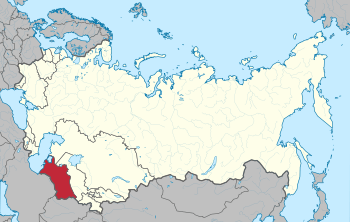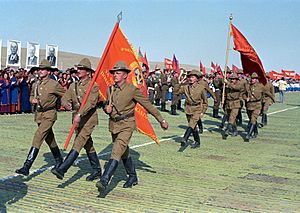Turkmen Soviet Socialist Republic facts for kids
Quick facts for kids
Turkmen Soviet Socialist Republic
|
|||||||||||||
|---|---|---|---|---|---|---|---|---|---|---|---|---|---|
| 1925–1991 | |||||||||||||
|
State emblem
(1978–1991) |
|||||||||||||
|
Motto: Әхли юртларың пролетарлары, бирлешиң! (Turkmen)
Ähli ýurtlaryň proletarlary, birleşiň! (transliteration) "Proletarians of all nations, unite!" |
|||||||||||||
|
Anthem: Түркменистан Совет Социалистик Республикасы Дөвлет Гимни
Türkmenistan Sowet Sosialistik Respublikasy Döwlet Gimni "State Anthem of the Turkmen Soviet Socialist Republic" |
|||||||||||||

Location of Turkmenistan (red) within the Soviet Union
|
|||||||||||||
| Status | Soviet socialist republic | ||||||||||||
| Capital | Ashkhabad | ||||||||||||
| Common languages | Turkmen · Russian | ||||||||||||
| Religion | State atheism | ||||||||||||
| Government | Unitary Marxist-Leninist single-party Soviet socialist republic (1925–1990) Unitary presidential republic (1990–1991) |
||||||||||||
| First Secretary | |||||||||||||
|
• 1924–1926 (first)
|
Ivan Mezhlauk | ||||||||||||
|
• 1985–1991 (last)
|
Saparmurat Niyazov | ||||||||||||
| Head of government | |||||||||||||
|
• 1925–1937 (first)
|
Kaikhaziz Atabayev | ||||||||||||
|
• 1989–1991 (last)
|
Khan Akhmedov | ||||||||||||
| Legislature | Supreme Soviet | ||||||||||||
| History | |||||||||||||
|
• Turkmen Oblast of the Turkestan ASSR
|
7 August 1921 | ||||||||||||
|
• Republic proclaimed
|
13 May 1925 | ||||||||||||
|
• Sovereignty declared
|
22 August 1990 | ||||||||||||
|
• Independence declared
|
27 October 1991 | ||||||||||||
|
• Independence recognized
|
26 December 1991 | ||||||||||||
| GDP (PPP) | 1990 estimate | ||||||||||||
|
• Total
|
$26.554 billion | ||||||||||||
| Currency | Soviet rouble (Rbl) (SUR) | ||||||||||||
| Calling code | 7 360/363/370/378/432 | ||||||||||||
|
|||||||||||||
| Today part of | Turkmenistan | ||||||||||||
The Turkmen Soviet Socialist Republic (often called Turkmen SSR or Soviet Turkmenistan) was one of the many republics that made up the Soviet Union. It was located in Central Asia.
This republic existed from 1925 to 1991. Before 1925, it was known as the Turkmen Oblast, part of the Turkestan ASSR. On May 13, 1925, it became its own republic within the USSR. Its borders stayed the same after that.
On August 22, 1990, the Turkmen SSR declared that its own laws were more important than Soviet laws. Then, on October 27, 1991, it officially became an independent country called Turkmenistan.
Geographically, the Turkmen SSR shared borders with Iran and Afghanistan to the south. To the west was the Caspian Sea. To the north was the Kazakh SSR, and to the east was the Uzbek SSR.
Contents
History of Turkmenia
How Russia Took Control
In the late 1800s, the Russian Empire began to take over land in what is now Turkmenistan. In 1869, they built a port city called Krasnovodsk (now Türkmenbaşy) on the Caspian Sea.
From there, Russian forces moved in and took control of the Khiva Khanate in 1873. Because some Turkmen tribes, like the Yomud, fought for the Khivan ruler, the Russians attacked Turkmen settlements. They killed many Turkmen people.
In 1881, Russian General Mikhail Skobelev captured Geok Tepe, a strong Turkmen fortress near Ashgabat. This defeat is now a national day of mourning and a symbol of pride for Turkmen people. After this, Russia slowly took full control of the area.
Later in 1881, Russia signed a treaty with Qajar Iran, setting the border that mostly remains today between Turkmenistan and Iran. A similar agreement was made with Afghanistan in 1897.
After Russia took over, the area was called the Transcaspian Region. It was managed by Russian military officers and officials who were often unfair. In the 1880s, a railway was built from Krasnovodsk to Ashgabat and then to Tashkent. Cities started to grow along this railway.
Forming the Turkmen SSR
When the October Revolution happened in 1917, bringing Soviet rule, there wasn't much revolutionary activity in Turkmenistan. However, before the revolution, Turkmen people had rebelled against Russian rule, like the 1916 uprising across Turkestan.
Their armed fight against Soviet rule was part of a larger movement called the Basmachi Revolt in Central Asia during the 1920s and early 1930s. Many Turkmen died in these fights.
In October 1924, Central Asia was divided into different areas based on ethnic groups. The Transcaspian Oblast of the Turkestan Autonomous Soviet Socialist Republic, along with parts of the Bukharan and Khorezm People's Republics, were combined. This created the Turkmen Soviet Socialist Republic (Turkmen SSR). It became a full republic of the Soviet Union. About 80% of its population was Turkmen.
During the early Soviet years, many changes happened. Nomadic groups were forced to settle down. By the late 1930s, most Turkmen lived in one place. The Soviet government tried to change traditional Turkmen life, affecting families, politics, religion, and culture. Many Russians and other Europeans moved to Turkmen cities. Some industries were built, and Turkmenistan's natural resources began to be used.
Under Soviet rule, the government attacked all religious beliefs, calling them old superstitions. Most religious schools and practices were banned, and many mosques were closed. An official Muslim Board was set up in Tashkent during World War II to oversee Islam in Central Asia. This board mostly served as a tool for Soviet propaganda.
Even though the government tried to stop it, some religious customs, like Muslim burials and male circumcision, continued. Most religious beliefs and knowledge were kept alive in rural areas as an unofficial form of Islam.
The Path to Independence
The Soviet government had a policy called "korenizatsiia," which meant promoting local cultures and languages. In the 1920s, the Turkmen SSR supported and funded native language theaters, publishing houses, and newspapers. They also created public schools for everyone.
The Turkmen language was standardized in the 1920s. Before this, most people couldn't read or write. Those who could often used other languages like Chaghtai or Persian. There was a big discussion about different Turkmen dialects. Eventually, a standard language was created, and the Arabic alphabet was simplified. Later, it was changed to the Cyrillic alphabet.
From the 1930s onward, Moscow kept strong control over the republic. The Communist Party of the Soviet Union (CPSU) helped create a Turkmen political leadership. However, it also promoted Russification, which meant making things more Russian.
In the 1920s and early 1930s, the government encouraged using the Turkmen language in all parts of the state. They also gave special opportunities to ethnic Turkmen in government and industry jobs. They even tried to make non-Turkmen people learn Turkmen.
But from the 1930s, the policy changed. Turkmen language was still used in areas like education and health. However, knowing Russian became necessary for most government jobs and career advancement. The government stopped actively trying to make Turkmen the main language of administration. From 1938, non-Russian students across the Soviet Union had to learn Russian fluently to continue their education.
Russian officials closely watched Turkmen leaders. Generally, the Turkmen leadership strongly supported Soviet policies. Moscow made almost all political decisions for the republic. Turkmenistan remained a quiet Soviet republic, except for a corruption issue in the mid-1980s.
The changes brought by Mikhail Gorbachev in the late 1980s, like glasnost (openness) and perestroika (restructuring), didn't affect Turkmenistan much. Many people there were self-sufficient.
When other Soviet republics started to claim more independence in 1988 and 1989, Turkmenistan's leaders also began to criticize Moscow. They said Moscow's economic policies were unfair and hurt the Turkmen people. In August 1990, Turkmenistan's Supreme Soviet (its main governing body) voted to declare its sovereignty.
In March 1990, Turkmenistan took part in a vote about the future of the Soviet Union. 98% of people voted to keep the Soviet Union. But after a coup attempt in Moscow in August 1991, Turkmenistan's communist leader, Saparmurat Niyazov, called for a public vote on independence. The official result was 94% in favor of independence.
The Supreme Soviet then declared Turkmenistan's independence from the Soviet Union on October 27, 1991. Turkmenistan officially gained independence on December 26, 1991.
Space Facilities
The Turkmen SSR had two active space facilities. They were located in the cities of Turkmenabat and Seydi. Both were equipped for launching rockets. The Soviet space program built rockets like Proton, Mir, and Soyuz there during the Cold War.
Development and Infrastructure
Much of Turkmenistan's modern infrastructure was built during the Soviet period. This included new cities, institutions, buildings, roads, power stations, hospitals, schools, and factories. These developments helped modernize the republic.
Russification and Names
When the Soviets came to power in the 1920s, people were asked to add a Russian ending to their names. For male names, "ev" or "ov" was added. For female names, "eva" or "ova" was added. In Russian, these endings mean "belonging to." This was part of an effort to create a sense of a unified Soviet people.
Politics and Government
Like other Soviet republics, Turkmenistan followed the Marxist–Leninist ideology. It was governed by a single party, the Communist Party of Turkmenistan. This party was a branch of the main Communist Party of the Soviet Union.
The politics of Turkmenistan were based on a one-party socialist republic. The Supreme Soviet was the republic's main law-making body. It had one chamber and was led by a Chairman. Its power was greater than both the executive and judicial branches. Its members met in Ashkhabad.
Religion Under Soviet Rule
Before Soviet rule, about 98% of people in Turkmenistan were Muslim. However, atheism (not believing in God) became the official state religion. In the early 1920s, the Soviet government effectively banned Islam in Central Asia, including Turkmenistan. Many mosques were destroyed, and books written in Arabic script were burned. In the 1930s, Turkmenistan eventually adopted the cyrillic alphabet for its written language.
Leaders of the Communist Party of Turkmenistan
- Ivan Mezhlauk (1924–1926)
- Shaymardan Ibragimov (1926–1927)
- Nikolay Paskutsky (1927–1928)
- Grigory Aronshtam (1928–1930)
- Yakov Popok (1930–1937)
- Anna Mukhamedov (1937)
- Yakov Chubin (1937–1939)
- Mikhail Fonin (1939–1947)
- Shadzha Batyrov (1947–1951)
- Sukhan Babayev (1951–1958)
- Dzhuma Durdy Karayev (1958–1960)
- Balysh Ovezov (1960–1969)
- Muhammetnazar Gapurow (1969–1985)
- Saparmurat Niyazov (1985–1991)
Heads of Government (Council of People's Commissars / Council of Ministers)
- Kaikhaziz Atabayev (1925–1937)
- Aitbay Khudaybergenov (1937–1945)
- Sukhan Babayev (1945–1951)
- Balysh Ovezov (1951–1958, 1959–1960)
- Dzhuma Durdy Karayev (1958–1959)
- Abdy Annaliyev (1960–1963)
- Muhammetnazar Gapurow (1963–1969)
- Oraz Orazmuhammedow (1969–1975)
- Bally Yazkuliyev (1975–1978)
- Chary Karriyev (1978–1985)
- Saparmurat Niyazov (1985–1986)
- Annamurat Hojamyradow (1986–1989)
- Han Ahmedow (1989–1991)
Images for kids
See also
 In Spanish: República Socialista Soviética de Turkmenistán para niños
In Spanish: República Socialista Soviética de Turkmenistán para niños





